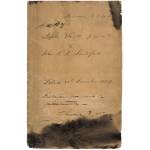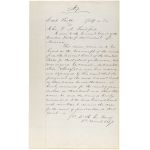Judgment in the U.S. Supreme Court Case Dred Scott v. John F. A. Sandford
3/6/1857
Add to Favorites:
Add all page(s) of this document to activity:

Add only page 1 to activity:
Add only page 2 to activity:
In this ruling, the U.S. Supreme Court stated that enslaved people were not citizens of the United States and, therefore, could not expect any protection from the federal government or the courts. The opinion also stated that Congress had no authority to ban slavery from a federal territory.
In 1846, an enslaved Black man named Dred Scott and his wife, Harriet, had sued for their freedom in St. Louis Circuit Court. They claimed that they were free due to their residence in a free territory where slavery was prohibited.
The odds were in their favor. They had lived with their enslaver, an army surgeon, at Fort Snelling, then in the free Territory of Wisconsin. The Scotts' freedom could be established on the grounds that they had been held in bondage for extended periods in a free territory and were then returned to a slave state. Courts had ruled this way in the past.
However, what appeared to be a straightforward lawsuit between two private parties became an 11-year legal struggle that culminated in one of the most notorious decisions ever issued by the Supreme Court. Scott lost his case, which worked its way through the Missouri state courts; he then filed a new federal suit which ultimately reached the Supreme Court.
On its way to the Supreme Court, the Dred Scott case grew in scope and significance as slavery became the single most explosive issue in American politics. By the time the case reached the high Court, it had come to have enormous political implications for the entire nation. Slavery had become the single most explosive issue in American politics.
On March 6, 1857, Chief Justice Roger B. Taney read the majority opinion, which stated that enslaved people were not citizens of the United States and, therefore, could not expect any protection from the federal government or the courts. The opinion also stated that Congress had no authority to ban slavery from a federal territory. This decision moved the nation a step closer to the Civil War.
The decision in Scott v. Sandford, considered by many legal scholars to be the worst ever rendered by the Supreme Court, was overturned by the 13th and 14th amendments to the Constitution, which abolished slavery and declared all persons born in the United States to be citizens of the United States.
In 1846, an enslaved Black man named Dred Scott and his wife, Harriet, had sued for their freedom in St. Louis Circuit Court. They claimed that they were free due to their residence in a free territory where slavery was prohibited.
The odds were in their favor. They had lived with their enslaver, an army surgeon, at Fort Snelling, then in the free Territory of Wisconsin. The Scotts' freedom could be established on the grounds that they had been held in bondage for extended periods in a free territory and were then returned to a slave state. Courts had ruled this way in the past.
However, what appeared to be a straightforward lawsuit between two private parties became an 11-year legal struggle that culminated in one of the most notorious decisions ever issued by the Supreme Court. Scott lost his case, which worked its way through the Missouri state courts; he then filed a new federal suit which ultimately reached the Supreme Court.
On its way to the Supreme Court, the Dred Scott case grew in scope and significance as slavery became the single most explosive issue in American politics. By the time the case reached the high Court, it had come to have enormous political implications for the entire nation. Slavery had become the single most explosive issue in American politics.
On March 6, 1857, Chief Justice Roger B. Taney read the majority opinion, which stated that enslaved people were not citizens of the United States and, therefore, could not expect any protection from the federal government or the courts. The opinion also stated that Congress had no authority to ban slavery from a federal territory. This decision moved the nation a step closer to the Civil War.
The decision in Scott v. Sandford, considered by many legal scholars to be the worst ever rendered by the Supreme Court, was overturned by the 13th and 14th amendments to the Constitution, which abolished slavery and declared all persons born in the United States to be citizens of the United States.
Transcript
Missouri - C. C. U. S.No. 7.
Dred Scott, Plff in Er
vs.
John F. A. Sandford
Filed 30th December 1854.
Dismissed for want of jurisdiction.
March 6th 1857
No. 7.
Dred Scott - Plff in Er
vs
John F. A. Sandford
In error to the Circuit Court of the United States for the District of Missouri.
This cause came on to be heard on the transcript of the record from the Circuit Court of the United States for the District of Missouri and was argued by counsel - on consideration whereof, it is now here ordered and adjudged by this court that the judgment of the said Circuit Court in this cause be and the same is hereby reversed for the want of jurisdiction in that court, and that this cause be and the same is hereby remanded to the said Circuit Court with directions to dismiss the case for the want of jurisdiction in that court.
Js. W. Ch. Mr. Taney
6th March 1857
This primary source comes from the Records of the Supreme Court of the United States.
National Archives Identifier: 301673
Full Citation: Judgment in the U.S. Supreme Court Case Dred Scott v. John F. A. Sandford; 3/6/1857; Dred Scott, Plaintiff in Error, v. John F. A. Sandford; Appellate Jurisdiction Case Files, 1792 - 2010; Records of the Supreme Court of the United States, Record Group 267; National Archives Building, Washington, DC. [Online Version, https://www.docsteach.org/documents/document/dred-scott-judgment, April 25, 2024]Activities that use this document
- From Dred Scott to the Civil Rights Act of 1875: Eighteen Years of Change
Created by the National Archives Education Team - From Slavery to Juneteenth: Emancipation and Ending Enslavement
Created by the National Archives Education Team - What Else Was Happening During the Civil War Era?
Created by the National Archives Education Team
Rights: Public Domain, Free of Known Copyright Restrictions. Learn more on our privacy and legal page.





